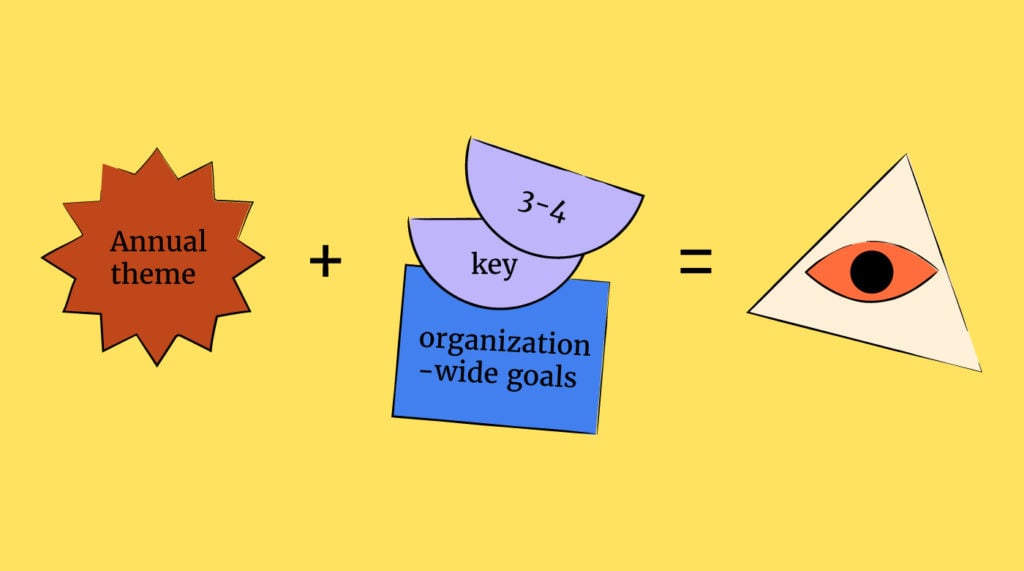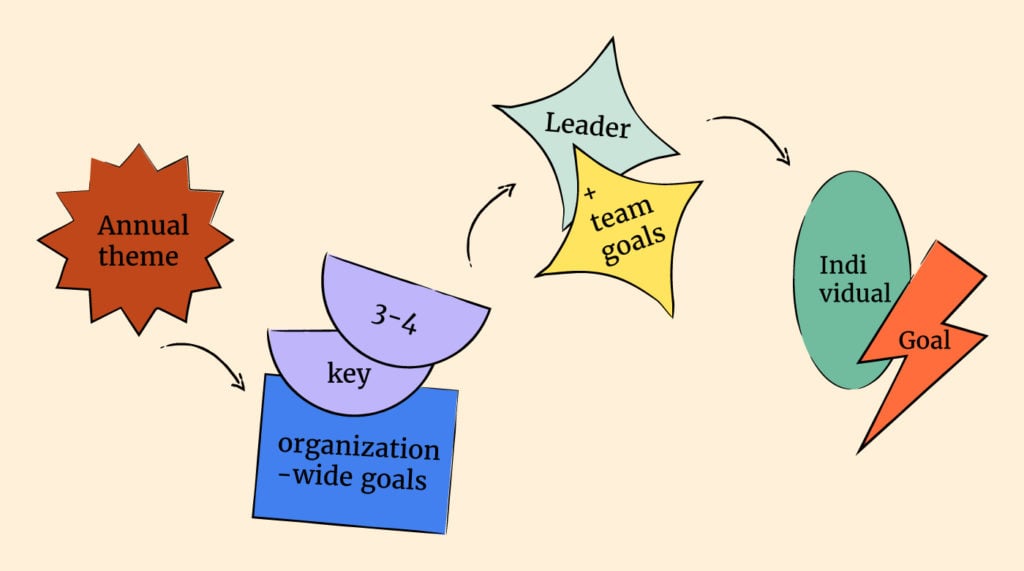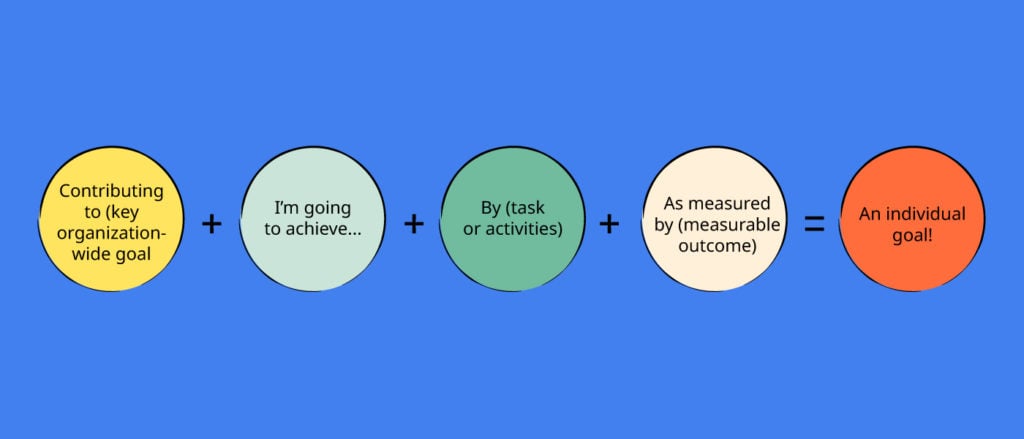Goals are the roadmap for an organization’s success.
However, all too often, goals aren't properly aligned with day-to-day action and decision-making. This often leads to missed opportunities and subpar performance.
The cascading goals method creates alignment between the high-level goals of the organization and those of teams and individuals.
I’m deeply immersed in organizational development and some might call me a bit obsessed with goals and the goal-setting process.
Here I share my best practices for getting goal-setting right in your organization and teams using the cascading goals framework.
What Are Cascading Goals?
“The goal is to ensure everyone is going in the same direction, with clear priorities, in a constant rhythm.”- Felipe Castro of Lean Performance
Cascading goals is a top-down approach to goal setting. It starts with setting a high-level theme for the year, key organization-wide goals, goals for leaders, departments, and teams, and, finally, individual employee goals.
When implemented successfully, this model allows individuals and teams to be both aligned and autonomous in delivering desired outcomes.
Additionally, regular communication and check-ins ensure everyone is on the same page and actively working toward achieving collective outcomes.
A not-so-fun stat: Only 16% of frontline workers have a clear understanding of how their work contributes to the strategic goals of the organization.
Cascading goals help people understand how their work contributes to the wider success of the organization.
Benefits Of Cascading Goals
There are many good reasons why cascading goals are becoming so popular.
- Alignment with vision and strategy: Cascading goals ensure that individual and team goals align with the broader objectives of the organization and facilitate priority setting.
- Improved communication: The process of cascading goals typically involves discussions and negotiations between different levels of an organization. This improves communication and ensures that everyone understands the bigger picture and their role in achieving it.
- Enhanced performance management: Cascading goals provide a framework for performance management. They offer clear criteria for evaluating individual and team performance and facilitating constructive feedback and professional development.
- Increased engagement and motivation: When employees understand how their work contributes to the organization's success which drives employee engagement.
- Facilitates easier resource management: With clear goals at each level, organizations can better manage and allocate resources, ensuring that efforts are not duplicated and resources are used efficiently.
I’ll now take you through how to implement a cascading goals model in your organization.
How To Implement Cascading Goals In Your Organization
1. Get clarity on organizational goals
“Clarity affords focus” – Thomas Leonard, personal coaching pioneer
The first real step in goal setting is to get clarity on what’s most important right now and why.
It’s the job of top-level leaders to provide clarity to their teams on what is most important to the organization.
Clarity in an organization includes building and socializing answers to these key elements:
- Mission or Purpose: Why does the organization exist?
- Vision: What is the vision for the future? How might we get there? If you need help getting started, check out these 15 Vision Statement examples.
- Values: What are the principles that guide behaviors and decisions?
- Strategic Plans: Where do we want to be in 3 years? 5 years? What outcomes are we looking to achieve that align with our mission and vision? How will our values drive us?
- Goals: What is most important for us to achieve in the near term? What focus areas will push the organization forward to achieve its vision?
In an organization with clarity, its mission, vision, and values are defined and evolve with the business. The strategic plan is shared widely, and people at all levels know how their work contributes to achieving those goals.
A good practice to drive clarity is for the executive level team to create a high-level theme for the year and key organization-wide specific goals you want to achieve to move forward in your strategic plan.
Combined, these elements create clarity that helps guide decision-making and drives goal alignment across the organization.

2. Develop strategic goals
“Goals are like a map. They help us determine where we want to end up, and give us personal direction on which to focus our energy.” - Catherine Pulsifer
The strategic planning process is a critical part of any organization's success.
However, all too often, organizations fail to achieve their desired results because their goals are not properly aligned with their actions.
You can fix this misalignment by starting at the top and cascading goals down to the individual level.
At least 3 weeks before the start of a new quarter, top leaders in an organization should work together to identify key strategic goals and desired outcomes.
They should do this not just for themselves, but also for their departments as reflected in the leader’s goal.
Leaders should be accountable for the outcomes delivered by their teams, as reflected in their individual goals.
This means that if the team misses the mark, the leader should also miss their goal. These goals should be connected and aligned. Win together, learn together.
For example, an HR leader might have a goal focused on accelerating hiring and onboarding to meet company growth goals, as measured by the number of hires in a quarter, with a specific numerical target.

While this leader likely won’t schedule and facilitate all of the interviews to meet this goal themselves, they’re responsible for the teams that will deliver these outcomes.
As such, they should be made accountable for supporting that team’s success in the form of a measurable goal.
If the team is falling behind, this incentivizes the leader to support the team in achieving their goal as a participant, not just an observer or evaluator of the team’s outcomes.
Each leader should set 3-5 goals for their department that reflect what is most important to achieve in their functional areas in the coming quarter.
Each goal should include what they’re going to achieve, what tasks, programs, or changes might be needed to achieve the goal, and how the goal will be measured.
We’ll talk more deeply about this goal-creation formula later on, so keep reading!
3. Publish goals transparently
"Transparency, honesty, kindness, good stewardship, even humor, work in businesses at all times." - John Gerzema
Once goals are set for leaders at the highest levels, they must then be made visible to the entire organization.
Publishing goals transparently helps everyone in the organization understand what’s most important, what each leader and team is working on, and gives key insight into interdependencies and collaboration opportunities across teams.
4. Develop goals at the team and individual level
“One of the keys to leadership is recognizing that everybody has gifts and talents. A good leader will learn how to harness those gifts toward the same goal.” – Ben Carson, former US Secretary of Housing and Urban Development
Once goals have been made clear by upper-level leaders, managers, and individuals can consider their area of responsibility and determine how they can contribute best.
Managers should consider the responsibilities of those on their team, the strategic goals defined by their leader, the key organization-wide goals their leader’s goals cascade from, and any additional team goals for the quarter.
From there, individual goals emerge based on what each team member is uniquely qualified to do and their areas of responsibility.
When I am setting goals with my teams, I hold a workshop to set goals together.
We meet as a team in the first week of the quarter and re-state and confirm the purpose of our team, review the goals of our higher-level leaders, and identify if there are any other key strategic items our team needs to achieve.
From there, we develop our team goals. Next, each person confirms their area of responsibility and determines how they can help. This is how goals are defined at the individual level, cascading down from the organization’s key goals.
There are many different ways to write goals, and each method has its strengths. I largely appreciate the SMART goals model, but I know some prefer OKRs.
In my experience, the best methodologies include a measurable outcome, usually a metric, so it's clear when the goal has been achieved.
Each written goal can follow this formula:

Note: When defining measurables, focus on outcomes, not outputs.
An HR specialist’s goal might include processing 5 promotions per week—so what?
Asking “So what?” will help you find the outcome to be measured. Processing promotions is an output, the outcome is that employees are promoted with little friction from HR.
The measurable outcome is that HR is easy to do business with, meaning managers will not seek to circumvent processes, thereby creating more work for everyone (eye roll).
Examples Of Aligned, Actionable Goals
| Role | Goal | How | Measure of Success |
| Customer Success Manager | Increase the retention of my customers. | Facilitating quarterly business reviews and partnering with technical support agents to ensure my customers are well-supported and informed on key issues. | 90% retention of all customers assigned to me. |
| Technical Support Representative | Achieve an increase in my customer satisfaction score across all of my tickets. | Ensure customers receive a response to all tickets within 4 business hours. If I’m unable to resolve a customer’s issue, I will replicate and document the issue when escalating to the next-level team, but retain ownership of the ticket until the issue is resolved. | An increase in my overall customer satisfaction score to an average of 4.5 out of 5 stars. Reducing my average first time to under 4 business hours. |
| HR Specialist | Improve employee retention | Create a new hire onboarding guide highlighting the key systems and processes that are most important for successful onboarding at the company. This guide will be posted to the company intranet. | At least 20 new employees highlight the guide as helpful to their onboarding experience. A 10% reduction in team questions via email that reference items covered in the guide. |
Connecting and aligning goals: an example
Aligning goals to key company goals and a leader’s goals allows alignment throughout the organization and enables autonomy in achieving the goals of the organization.

In many cases, goals will be aligned clearly from key business goals through to individual goals.
But, at times, there may be team or manager goals that don’t directly connect to goals of leaders higher in the hierarchy but are still important to achieve and connect well to an annual theme.
That’s totally OK!
These goals are still important and are worth documenting and achieving to move the organization forward.
Cascading Goals Best Practices
Set a quarterly cadence
In my experience, organizations move at a pace that makes individual annual goals obsolete almost immediately after they’ve been set.
Conditions change, markets emerge, roles shift, and products evolve. This is why companies that set performance goals quarterly can generate 31% more returns than those reassessing annually.
If your organization runs fast and you want to achieve more, stop setting annual goals for individuals. Instead, set quarterly goals and evaluate their relevance, necessity and progress weekly or bi-weekly.
In my teams, we set goals at the beginning of each quarter and evaluate their relevance, necessity, and progress weekly or bi-weekly.
We have tolerance for changing priorities at the beginning of the quarter, but also make sure we’re doing what we said we were going to do. It's a fine balance. Commit and go!
Here’s a typical goal-setting schedule for my group, repeated quarterly:
- 3 weeks before the quarter begins: Evaluate key projects, priorities, and organizational goals. During this time, the highest-level leaders also publish their goals with full transparency. The entire organization reviews and considers them as a core component of their team and individual goal planning.
- 1-2 weeks before the quarter begins: Align with cross-functional teams on group projects. If you need something from another team to achieve a larger goal, get on their agenda—be sure they are setting goals in alignment with organization-wide projects.
- The week the quarter begins: Meet as a team to align on purpose, priorities and set your own goals. Confirm goals with other departments and get all goals on paper (or documented in a tool).
- Weekly or bi-weekly, over the course of the quarter: Write a quick progress update on all goals. Evaluate goals to be sure priorities are reflected accurately. Communicate between teams on goal progress and be sure any dependencies are considered when scheduling key activities.
- Throughout the quarter: Execute, execute, execute! Document progress throughout and communicate constantly.
- Last 3 weeks of the quarter: Repeat step 1 to prepare for the next quarter.
- End of the quarter: Celebrate successes! Meet as a team to report on what was achieved and talk through what will be most important to achieve in the next quarter.
Setting quarterly goals and monitoring progress weekly or bi-weekly gets your teams moving forward with focus.
The more you practice this cadence of goal setting in performance reviews, the more lightweight it will feel and the more effective it will be.
Get leadership buy-in
“Set realistic goals, keep re-evaluating, and be consistent.” – Venus Williams
Leadership buy-in is essential for implementation and supporting the cascading goals process. Without support from key leadership, the goals program risks being considered extracurricular.
With buy-in from the highest levels of your organization, you might be able to consider tying goals to compensation.
Bonuses are often tied to goal attainment, and the cascading goals method fits performance-based compensation well as it includes measurable outcomes that can be monitored and reported over time.
When it’s time to get started, introduce the model, get support, and lead your teams in committing to goals. Make the goals visible, and work regular goal updates into your standard workflow.
Use technology
Keeping track of goals continuously with weekly or bi-weekly documented updates, either in a shared document or spreadsheet, can be laborious.
Goal-setting software helps with setting and tracking goals. You can use it to display goals as they align across the org and visualization tools help everyone see exactly how close they are to achieving each goal.
Alternatively, you might want to use OKR software if OKRs are your jam, or performance management software will likely include goal-tracking tools.
Good practices in timing and cross-team considerations
“A goal without a timeline is just a dream.” – Robert Herjavec
As you implement and begin running your goals program, be aware of the cyclical nature of the quarterly goals process.
It keeps going, quarter after quarter!
The first few quarters might feel a bit clunky, but stay the course! Teams and individuals will become accustomed to the practice and it will certainly get easier and better understood over time.
In many cases, achieving cross-functional organizational goals requires multiple teams and individuals to each complete a portion of the work. In these cases, consider setting specific due dates for goals that have downstream dependencies.
30% of organizations cite failure to coordinate across units as the greatest challenge to executing strategy.
When you are working on organization-wide goals, collaboration and planning with other teams is critical to your collective success.
Huddle with the teams you work with most closely before the start of the quarter so you can get on their agenda before they set and lock in their goals.
I collaborate consistently with a few teams, and we have set a recurring meeting before the start of each quarter to get aligned and on each other’s agenda.
It genuinely works!
Cascading Goals Worksheet
To help you get started, use the below worksheet to help get clarity on your organization’s most important outcomes, key business goals, and leader goals, and then start writing goals for individuals using the goals formula outlined in this article.

Get our Cascading Goals Worksheet!




